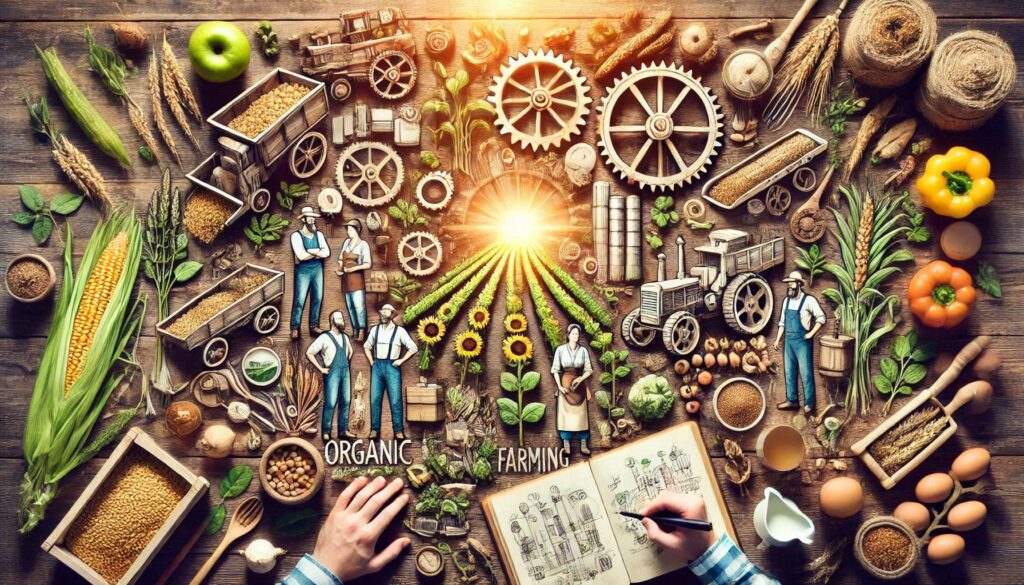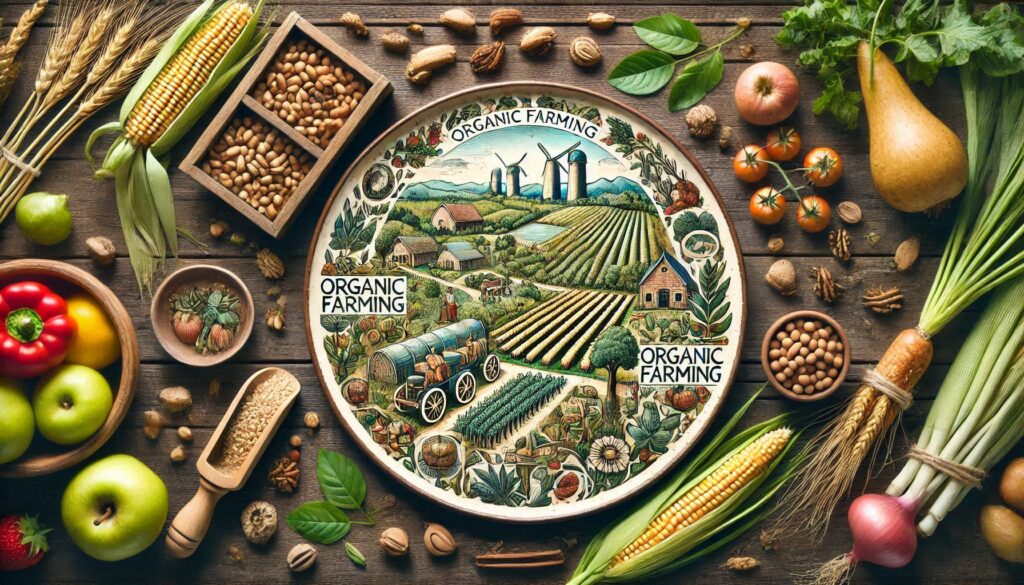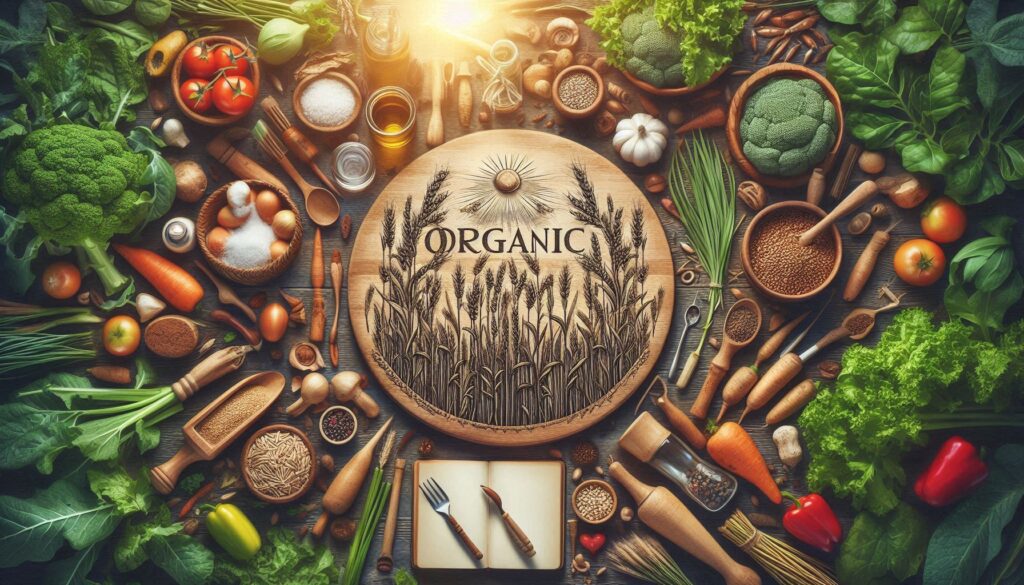Organic farming is more than a recent movement; it is deeply rooted in the history of human agriculture. From ancient civilizations to the modern-day organic movement, the principles of working in harmony with nature have evolved to meet the demands of sustainable agriculture. In this blog, we’ll explore the fascinating journey of organic farming—tracing its origins, transformation through the ages, and the trends shaping its future.

Ancient Origins: The Birth of Organic Agriculture
Long before the advent of chemical fertilizers and pesticides, ancient civilizations practiced what we now call organic farming. These methods were driven by necessity, as early farmers relied on natural processes to grow their crops and raise livestock.
1. Early Techniques
- Crop Rotation: Ancient Egyptians and Romans used crop rotation to maintain soil fertility and prevent nutrient depletion.
- Composting: Farmers in ancient China and India developed composting techniques to recycle organic waste into nutrient-rich soil amendments.
- Irrigation: Early civilizations like Mesopotamia introduced advanced irrigation systems to manage water efficiently.
2. Indigenous Knowledge
- Indigenous farming communities worldwide embraced sustainable practices like agroforestry, intercropping, and polyculture.
- Spiritual and cultural beliefs often guided these practices, emphasizing respect for the land and its ecosystems.
The Agricultural Revolution: Shifting Paradigms

The Agricultural Revolution of the 18th and 19th centuries brought transformative changes to farming. While industrialization increased productivity, it also led to the decline of traditional organic methods.History of Organic Farming: The Evolution of Organic Farming – From Ancient Practices to Modern Trends
1. The Rise of Synthetic Inputs
- The invention of chemical fertilizers in the mid-19th century marked a significant shift in agriculture.
- Pesticides and herbicides became widespread, providing short-term solutions to pest and weed problems.
2. Impact on Soil and Ecosystems
- Overreliance on synthetic inputs began depleting soil health and harming biodiversity.
- By the early 20th century, some scientists and farmers began questioning the long-term viability of these practices.
The Birth of the Modern Organic Movement
The modern organic farming movement emerged as a response to the industrialization of agriculture. Visionaries and pioneers laid the groundwork for a new approach to sustainable farming.
1. Key Figures
- Sir Albert Howard: Known as the “father of modern organic farming,” Howard’s research in India emphasized composting and soil health.
- Lady Eve Balfour: Her book The Living Soil and the establishment of the Soil Association in 1946 championed organic principles.
- J.I. Rodale: An American advocate, Rodale popularized organic farming through publications like Organic Farming and Gardening magazine.
2. Organic Certification
- In the 1970s and 1980s, organic certification standards were developed to formalize organic farming practices.
- Organizations like the USDA and IFOAM (International Federation of Organic Agriculture Movements) began regulating organic labeling.
Organic Farming in the 21st Century

The 21st century has seen exponential growth in organic farming, driven by consumer demand for healthier and more sustainable food options.
1. Technological Advancements
- Precision agriculture and modern tools help organic farmers optimize yields while minimizing environmental impact.
- Innovations in pest management, such as pheromone traps and beneficial insect habitats, reduce the need for chemical inputs.
2. Market Trends
- The global organic food market has grown significantly, with consumers increasingly prioritizing health and sustainability.
- Organic produce, dairy, and processed foods are now widely available in mainstream supermarkets.
3. Challenges
- Organic farming remains labor-intensive and costly compared to conventional methods.
- Climate change presents new challenges, including unpredictable weather patterns and the need for resilient crops.
Principles That Stand the Test of Time
Despite the evolution of agriculture, the core principles of organic farming remain consistent:
- Soil Health: Maintaining soil fertility and structure through natural amendments.
- Biodiversity: Encouraging a variety of plants, animals, and microorganisms to thrive.
- Sustainability: Using renewable resources and preserving ecosystems for future generations.
- Animal Welfare: Providing ethical treatment and natural living conditions for livestock.
The Future of Organic Farming
Organic farming is poised to play a crucial role in addressing global challenges like food security, climate change, and biodiversity loss. Future trends include:
- Regenerative Agriculture: Going beyond sustainability to restore degraded ecosystems.
- Urban Organic Farming: Expanding organic practices into urban environments through vertical farms and rooftop gardens.
- Digital Integration: Leveraging AI, IoT, and blockchain to improve efficiency and traceability in organic supply chains.
- Global Collaboration: Strengthening international networks to share knowledge and promote organic practices worldwide.
Conclusion
The history of organic farming is a testament to humanity’s enduring relationship with the land. From ancient practices rooted in necessity to modern movements driven by sustainability, organic farming has continually adapted to meet the challenges of each era. As we move forward, embracing the principles and innovations of organic farming will be vital in creating a healthier, more resilient world.
What aspect of organic farming’s history inspires you the most? Share your thoughts in the comments below and join the conversation!
Here are the top questions to ask people on organic farming, and related topics:
1. What is the history of organic farming?
The history of organic farming dates back to ancient agriculture when farmers relied on natural inputs like manure, compost, and crop rotation. These traditional practices were sustainable and chemical-free. The term “organic farming” emerged in the early 20th century, popularized by pioneers like Sir Albert Howard, who studied Indian farming techniques and emphasized soil health. Organic farming gained momentum in response to the industrialization of agriculture and the widespread use of synthetic chemicals post-World War II. By the 1970s, growing environmental and health concerns spurred the modern organic movement, leading to the establishment of certification standards. Today, organic farming blends ancient methods with scientific advances to create a sustainable, regulated alternative to conventional farming.
2. How are organic farming methods different from traditional methods followed throughout humankind?
Traditional farming and organic farming share similarities but differ in structure and intent. Traditional methods relied on natural inputs like manure, crop residues, and intercropping, often shaped by cultural knowledge and environmental adaptation. These practices were chemical-free but lacked formal guidelines or scalability. Organic farming modernizes traditional techniques, banning synthetic chemicals, GMOs, and artificial additives under strict certification standards. It emphasizes soil health, biodiversity, and sustainability, using scientifically backed practices like crop rotation, natural pest control, and organic fertilizers. While traditional methods evolved locally, organic farming integrates global regulations to meet modern consumer demands for sustainable, certified food.
3. What are the biggest organic farm scams in history?
Organic farm scams exploit the premium prices of organic products by mislabeling non-organic goods. A major example is the 2017 U.S. grain fraud, where $140 million worth of conventional grain was falsely labeled organic. In Europe, fraudsters sold non-organic produce under organic certification, undermining consumer trust. India has also faced issues with fake certifications and mislabeled exports. These scams often involve poor oversight, fraudulent documentation, or importing mislabeled goods from countries with lax enforcement. They harm genuine farmers and consumers, prompting stricter audits, traceability measures, and penalties to safeguard the integrity of organic farming.
4. What is the theory of evolution? Is it still a scientific theory?
The theory of evolution, introduced by Charles Darwin, explains how species change over time through natural selection. Organisms better adapted to their environments survive and reproduce, passing traits to offspring. Supported by fossil records, genetic studies, and observed adaptations, it remains a cornerstone of biology. Scientific theories, unlike hypotheses, are well-substantiated frameworks explaining natural phenomena. Evolution is constantly reinforced by new discoveries, from DNA sequencing to microbial evolution. Detractors, often driven by religious or ideological beliefs, misunderstand the term “theory” as speculative rather than evidence-based. Despite controversies, evolution is universally accepted in the scientific community.
5. Why do some people say evolution isn’t true anymore?
Critics of evolution often stem from religious or ideological perspectives, viewing it as incompatible with creationist beliefs. Misunderstandings about the scientific meaning of “theory” further fuel doubts, with skeptics equating it to conjecture rather than evidence-based explanation. Some cite gaps in the fossil record or misinterpret scientific debates as flaws in the theory. However, evolution is continually supported by evidence, including genetics, fossils, and observed changes in species. Resistance to evolution persists due to education gaps, cultural factors, and ideological resistance rather than scientific shortcomings.
6. Who were the scariest-looking soldiers/warriors in history?
History’s scariest warriors include the Viking berserkers, feared for their wild, frenzied combat style and intimidating animal-skin attire. The Mongol horsemen struck terror with their relentless invasions and advanced cavalry tactics. Samurai warriors, with their distinctive armor and skill in close combat, combined discipline with a fearsome appearance. Other examples include the Zulu warriors, whose ferocity and tactical brilliance under Shaka Zulu terrified opponents, and the Aztec Jaguar Warriors, dressed in animal skins to invoke spiritual power. These warriors’ appearances, combined with their fearsome reputations, made them legendary figures in history.
7. What makes food organic? Isn’t all food organic?
Organic food is produced without synthetic chemicals, GMOs, or artificial additives, relying on natural farming methods. Organic certification requires adherence to strict standards, including using organic fertilizers, natural pest control, and maintaining soil health. While all food is “organic” in the chemical sense (carbon-based), the term in agriculture refers to a regulated, sustainable production system. Non-organic food, produced conventionally, often involves synthetic fertilizers, pesticides, and genetic modification, distinguishing it from certified organic produce.
8. When did the organic food movement begin?
The organic food movement began in the early 20th century as a response to industrialized agriculture. Pioneers like Sir Albert Howard and Rudolf Steiner promoted sustainable farming methods emphasizing soil health and natural processes. The movement gained traction in the 1940s and 1950s, opposing the widespread use of synthetic chemicals post-World War II. By the 1970s, environmental and health concerns popularized organic farming, leading to certification programs and organic markets. Today, it’s a global phenomenon, driven by consumer demand for sustainable, chemical-free food.




Your article helped me a lot, is there any more related content? Thanks!
Can you be more specific about the content of your article? After reading it, I still have some doubts. Hope you can help me.
Can you be more specific about the content of your article? After reading it, I still have some doubts. Hope you can help me.
Thank you for your sharing. I am worried that I lack creative ideas. It is your article that makes me full of hope. Thank you. But, I have a question, can you help me?
I don’t think the title of your article matches the content lol. Just kidding, mainly because I had some doubts after reading the article.
Thank you for your sharing. I am worried that I lack creative ideas. It is your article that makes me full of hope. Thank you. But, I have a question, can you help me? https://accounts.binance.com/en/register-person?ref=JHQQKNKN
Can you be more specific about the content of your article? After reading it, I still have some doubts. Hope you can help me.